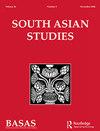Mixed Methodologies: Collaborative Approaches to Indus Tiger Seals
IF 0.7
0 ASIAN STUDIES
引用次数: 1
Abstract
Seals and other inscribed materials of the Indus Civilization (2600–1900 BCE) are a valuable source of data for studying this ancient cultural system, from writing, craft production, and economics, to art and ideology. In the absence of deciphered texts, detailed comparative studies of these materials allow us to explore their roles and significance in the organizational dynamics of one of the world’s earliest urban societies. This article contributes to the study of inscribed objects by applying complementary methodologies from art history and archaeology to the examination of seals and related artifacts that depict the tiger motif. It explores the consistency and variability in these objects as a reflection of the unique carving styles and techniques employed to make them, the distinct identities that they embody, and the ideas embedded within them. Identified patterns provide insights into the production strategies, shared ideologies, and potential meanings of this uniquely South Asian icon and highlight larger issues of Indus sociopolitical organization and integration. This innovative approach for investigating inscribed materials allows for a deeper exploration of their role in and reflection of the unique cultural systems that defined the Indus during the third millennium BCE.混合方法:印度河虎海豹的合作方法
印度河文明(公元前2600-1900年)的印章和其他铭文材料是研究这一古老文化体系的宝贵数据来源,从文字、工艺生产、经济到艺术和意识形态。在缺乏解密文本的情况下,对这些材料进行详细的比较研究,使我们能够探索它们在世界上最早的城市社会之一的组织动态中的作用和意义。本文通过运用艺术史和考古学的互补方法来研究刻画老虎主题的印章和相关文物,从而对铭刻物品的研究做出贡献。它探讨了这些物体的一致性和可变性,反映了独特的雕刻风格和制作它们的技术,它们所体现的独特身份,以及嵌入其中的思想。确定的模式提供了对这个独特的南亚图标的生产策略、共同意识形态和潜在意义的见解,并突出了印度河流域社会政治组织和整合的更大问题。这种研究铭刻材料的创新方法可以更深入地探索它们在公元前第三个千年定义印度河的独特文化体系中的作用和反映。
本文章由计算机程序翻译,如有差异,请以英文原文为准。
求助全文
约1分钟内获得全文
求助全文

 求助内容:
求助内容: 应助结果提醒方式:
应助结果提醒方式:


